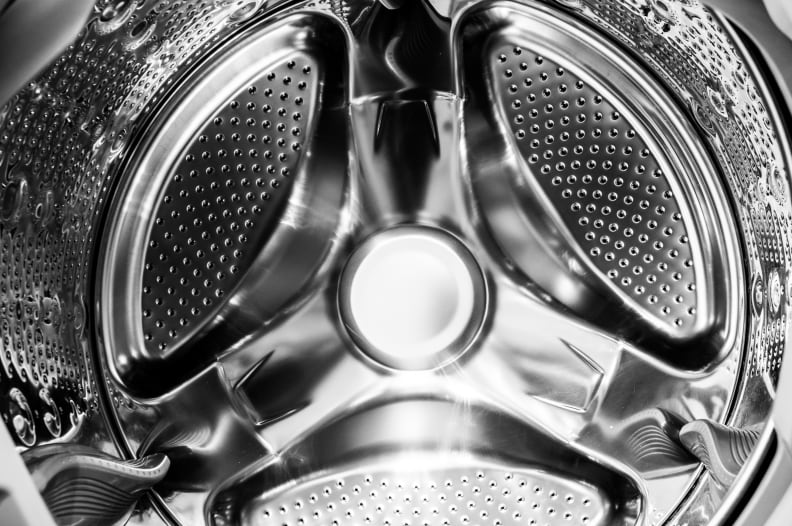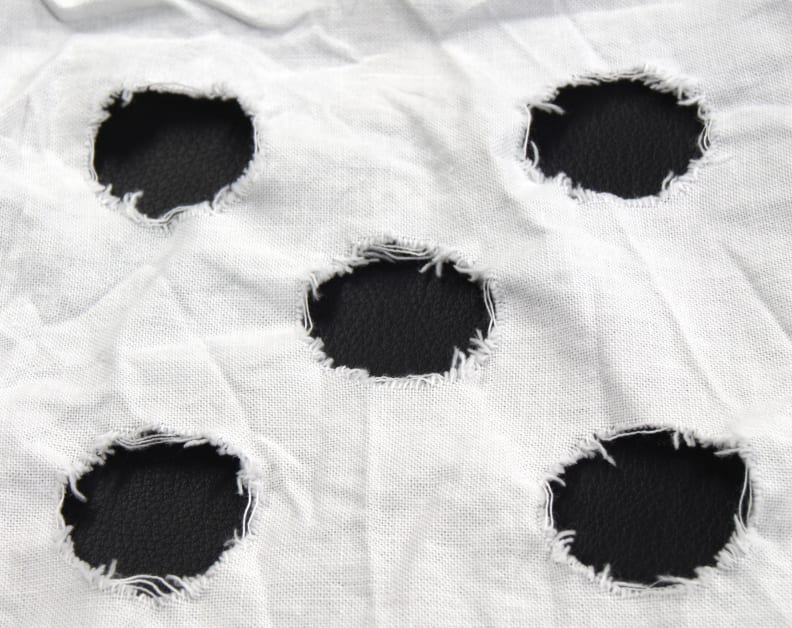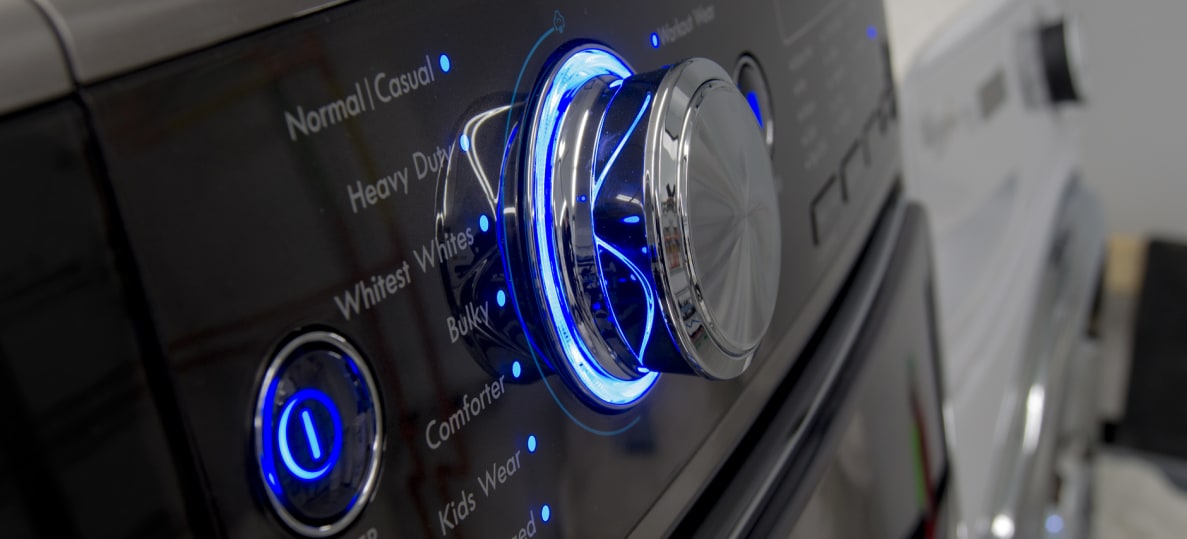All that speed doesn't imply a performance sacrifice either, as cleaning ability is on par with other machines in this price range. Its features, however, put this Kenmore above and beyond. A Sanitize cycle, the ability to add steam, and a drum light add a touch of luxury.
These factors combined make the Kenmore 41583 a master of all trades. If you have a large family, it has design features for that. Always on the go and need to freshen a few dress shirts constantly? The 41583 has you covered. Turns out, this Elite is actually made for everyone.
Design & Usability
Well thought out
The Kenmore 41583 is the replacement for our 2012 and 2013 Best of Year product, the Kenmore 41472. It adds a faster wash cycle and updates an already-sleek design, and luckily retains the 41472's excellent performance.
It feels like a lot of effort went into how consumers would interact with the the Kenmore 41583. The moment you turn it on, the control panel lights up in pleasant blue. Easy on the eyes also means easier to read, especially in dark basements.
{{ photo_gallery name="Kenmore" }}
When you open up the 41583, a drum light comes on. The well-lit 4.5 cu.ft. drum can easily fit a family of four's laundry. When it's not in use, a magnetic stopper props the door ajar. This allows the moisture inside to evaporate–eliminating the mildew odors that front loaders are prone to.

The 41583 can fit 4.5 cubic feet of laundry.
Ultimately, the design of the Kenmore 41583 might help diminish some of the dread associated with laundry. Working up the motivation to tackle those dirty socks is half the battle.
Performance & Features
All washed up... in a good way
Sears claims the 41583 agitates with six distinct motions. It's designed to keep clothes from getting bunched up, and you can't argue with the results we got.
The 41583's cleaning performance was good across the board. The Heavy Duty cycle proved to be the most powerful, and it absolutely cut through tough stains like cocoa. The only catch is that it takes an hour and a half to complete.
On the opposite end of the spectrum is Express Wash. At fifteen minutes, it's one of the shortest cycles we've ever encountered. However, it's short duration is proportional to its cleaning ability. That was most evident on oily dirt stains. That's not surprising, considering that removing oil requires time for detergent to do its job.
Speaking of the Express Wash, the 41583 is one of the fastest washers we've ever tested, and that's thanks for a feature called Accela-Wash. Using this mode, the Normal cycle took only 30 minutes to complete, with virtually no decrease in stain removal performance when compared to great washers that take more time.
This version of Accela-Wash cuts a full eight minutes off the Normal cycle time on its predecessor, the Kenmore 41472.
On the clothes wear front, the Kenmore 41583 did not exceed expectations. Our tests showed that it damaged clothing at a similar rate of other washers in its class. So, if you've owned a front loader before, you'll know what to expect.
For in-depth performance information, please visit the Science Page.
Conclusion
Fast and effective
Many washing machines do a fine job cleaning clothes. The Kenmore 41583 has enough advantages to put it ahead of the pack. Even if you only do laundry once a week, Accela-Wash could save you up to 260 hours over the lifetime of the washer.
Although it's quick, cleaning performance is better than other machines in the thousand dollar price range. And this model has all the right usability touches, like a drum light and magnetic bumper. Bottom line: If you're in the market for a front-loader, the Kenmore 41583 has something to offer.
By the Numbers
Science is the bedrock of our review process. For washing machines, it's all about cleaning performance and efficiency, and this new Kenmore does well in all accounts.
Cleaning Performance
During our cleaning performance tests we use controlled, pre-stained cloth swatches. The swatches are coated in common substances like sweat, dirt, and cocoa. Each stain strip is placed into an eight-pound load of laundry and washed with standardized detergent. When the cycle is finished, we take the strips out and analyze them with a photospectrometer to determine exactly how much of each stain has been lifted.

Before and after test stain results using the Normal cycle. From left to right: control, sweat, dirt, blood, cocoa, and red wine.
The Kenmore 41583 had some issues with dirt stains, but did particularly well with protein-based ones. We were also encouraged by this machine's handling of both cocoa and blood, which are on the opposite sides of the pH scale.
The Heavy Duty cycle was long, at an hour and a half, but it was also clearly the best. It showed no obvious signs of weakness, outperforming industry standards across the board. The Normal cycle was also outstanding, and took just 30 minutes. Stain removal rates were only 7% less than Heavy Duty, but the cycle time was exceptionally quick.
Efficiency
Efficiency tests take two factors into account: what goes in and what goes out. In terms of what goes in—water and electricity—the Kenmore 41583 is very efficient. Based on average national costs and use patterns, we estimate an annual running cost of around $31.50.
What comes out is wet laundry. The wetter your laundry is, the harder your dryer will have to work, using more electricity. On average, the 41182 spun out 55% of excess water. Bad machines leave behind 75%, and anything that's at least near the 50% mark gets a thumbs-up from us.
Clothes Wear
The amount a washer damages clothing is measured via mechanical action strips. The pieces of cloth are machine cut and placed in every wash cycle. When they are taken out, the frayed strands are tallied up to determine how rough a give cycle was.

This is an example of a used mechanical action strip. The frayed strains with the circles are tallied up to determine the amount of clothes wear.
The roughest cycle was the Heavy Duty cycle. After an hour and a half of tumbling, the average strip accumulated 64 frayed strands, which is on par with the average Heavy Duty cycle. The most gentle cycle turned out to be the Delicates cycle. That cycle caused 38 strains of damage, which is a little less gentle than the best Delicates cycles we've seen.
Meet the tester
Jonathan Chan currently serves as the Lab Manager at Reviewed. If you clean with it, it's likely that Jon oversees its testing. Since joining the Reviewed in 2012, Jon has helped launch the company's efforts in reviewing laptops, vacuums, and outdoor gear. He thinks he's a pretty big deal. In the pursuit of data, he's plunged his hands into freezing cold water, consented to be literally dragged through the mud, and watched paint dry. Jon demands you have a nice day.
Checking our work.
Our team is here for one purpose: to help you buy the best stuff and love what you own. Our writers, editors, and lab technicians obsess over the products we cover to make sure you're confident and satisfied. Have a different opinion about something we recommend? Email us and we'll compare notes.
Shoot us an email



